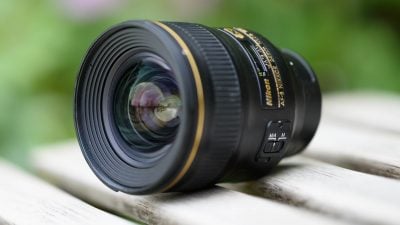Nikon 24mm f1.8G review
-
-
Written by Thomas
Quality
Longitudinal Chromatic Aberration and focus shift
With lenses offering an aperture of f2.8 or larger I test for longitudinal CA (loCA, a.k.a. “axial color” or “bokeh CA”). The new Nikon shows a clear magenta coloration in the foreground (left) and greenish hues in the background (right). This also shows up in real-life shots. By f5.6 the effect is almost gone. The test also revealed that there is some focus shift.
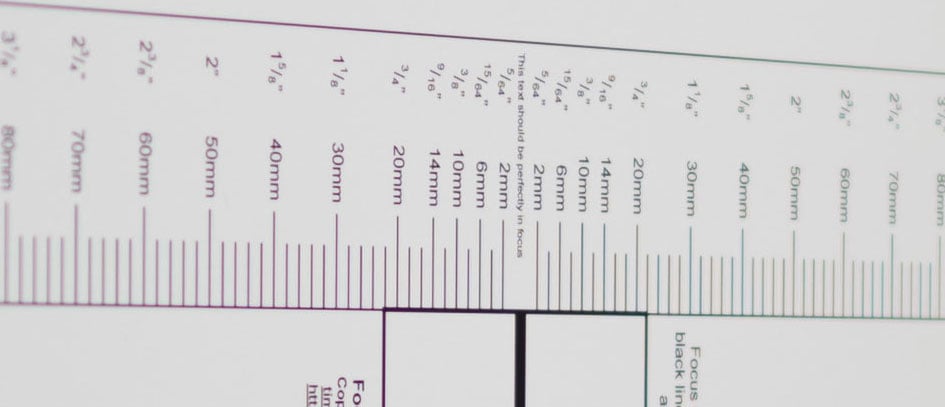
Above: Nikon 24/1.8G Longitudinal Chromatic Aberration (loCA) at f1.8. 100% crop, left = foreground, right = background
Sharpness and contrast
Let’s have a look at the theoretical performance of the new lens first and compare it to the performance of the Nikon 24mm f1.4G :
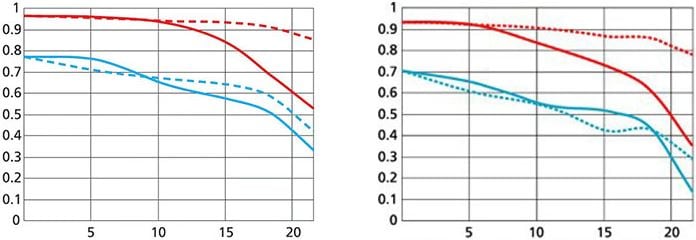
Above: MTF of Nikon 24/1.8G at f1.8 (left), Nikon 24/1.4G at f1.4 (right)
These charts show the lens-performance at the largest aperture. Higher values are better and the closer the dotted and the continuous lines of each color are together the less astigmatism (= resolution depends on the orientation of the test-pattern) the lens has. The x-axis displays the distance from the optical axis (=center of the sensor) in mm. I’ll show you the real-life performance at 4 mm (center), 13 mm (DX-corner), and 20 mm (FX-corner) on a D810.
But let’s see how this theoretical performance translates into real life results in the sharpness test based on Siemens-stars.
What follows are near-center results (first column) followed by DX-corner results and FX-corner results on a D810. The D810 results from the DX-corner should be a very good approximation for performance on a 16MP DX sensor (like the D7000), because the pixel-pitch of both sensors are the same. But differences in the AA-filter and micro-lens-design of a D810 and a D7000 might yield different end-results.
Processing was done in Lightroom 5.7.1 from RAW at Camera Standard settings. Noise-reduction is set to 0, sharpening to 35/0.5/36/10, with no extra tone, color, or saturation-adjustment. White-balance was adjusted to a neutral white and I did some exposure compensation to make the brightness match. CA-removal is ON.
The following are all 100% crops!
Nikon 24/1.8G on Nikon D810; 100% crop from center, DX-corner, FX-corner

Above: 24mm, f1.8

Above: 24mm, f2.0

Above: 24mm, f2.8

Above: 24mm, f4.0

Above: 24mm, f5.6

Above: 24mm, f8.0

Above: 24mm, f11

Above: 24mm, f16
These 100% crops directly from a 36MP D810 sensor show that this lens delivers a very good performance at the center right from the start. The focus shift (as signified by the magenta color-shift in the f2.8 crop and to a lesser extend the f4.0 crop) does not prevent the lens from sharpening up nicely when stopping down. It also is pretty good in the FX-corner with a little less contrast but good resolution of fine details. The weak spot of this lens seems to be the border of the DX image circle: there the lens is outright mushy and improves notably only at f4.0. Diffraction is setting in at f11 and there is some field-curvature as I had to optimize focus for each crop a bit. Distortions seems pretty well controlled for such a wide angle lens.
Following is the performance of the new 24/1.8G at f2.0 (1st row) directly compared to the Sigma 24/1.4 Art (2nd row) and the Nikon 24/1.4G (3rd row) at f2.0:

Above: Nikon 24/1.8G at 24mm, f2.0

Above: Sigma 24/1.4 Art at 24mm, f2.0

Above: Nikon 24/1.4G at 24mm, f2.0
Both f1.4 lenses produce a crisper result in the center and the Nikon also delivers the better DX-corner. In the FX-corner the new Nikon 24/1.8G is in the lead closely followed by the Sigma and the Nikon 24/1.4G.
Following is the performance of the new 24/1.8G at f2.8 (1st row) directly compared to the Tamron 15-30/2.8 VC at f2.8 (2nd row) and the new Nikon 24-70/2.8E VR (last row):

Above: Nikon 24/1.8G at 24mm, f2.8

Above: Tamron 15-30/2.8 VC at 24mm, f2.8

Above: Nikon 24-75/2.8E VR at 24mm, f2.8
The Tamron zoom performs surprisingly well against the fixed focal. Its center is as sharp as the Nikon 24/1.8G at f2.8 and does not suffer from color aberrations. The DX-corner is much better than with the Nikon. And the FX-corner of the Tamron zoom is pretty close to the Nikon 24/1.8G. The new Nikon 24-70/2.8E VR is also better in the DX-corner than the Nikon 24/1.8G but has the weaker FX-corner. In the center it is good, but not as bitingly sharp as the other two lenses.
Performance at long distances
The Siemens-star test-targets are shot at a distance of 40x focal length (i.e. at 1m for 24mm focal length). But performance of lenses also depends on the shooting distance. Therefore I present another series of test-shots of a landscape dubbed the “Unremarkables” where you can measure distances in km, not meter. Processing was done in Lightroom 5.7.1 from RAW at Adobe Standard settings. Noise-reduction is set to 0, sharpening to 35/0.5/36/10, with no extra tone, or saturation-adjustment. There’s no tinkering with vignette-control so you see it here as it is produced by the lens. Focus was acquired at the largest aperture manually and not changed for other apertures.
You can click on each image to access the large original. Please respect our copyright and only use those images for personal use.
The main image shows the complete scene at f5.6 to give you an impression of the angle of view and to judge vignetting. But you can access the respective shots at f8.0, f11 and f16 via the links beneath each image. All shots were made at ISO 64. Following the main image are 100% crops from the center, the DX-corner and the FX-corner from f1.8 down to f8.
Nikon 24/1.8G shot with Nikon D810
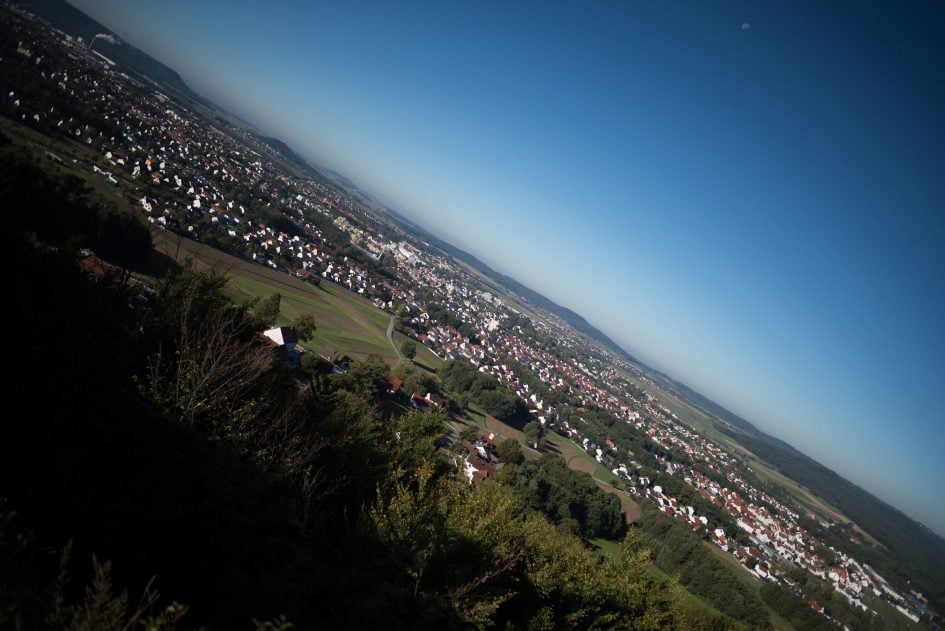
Above: at 24mm, f1.8; also available at f2.0, f2.8, f4.0, f5.6, f8.0, f11, f16

Above: 24mm, f1.8; 100% crop from center, APS-C/DX-corner, FF/FX-corner

Above: 24mm, f2.8; 100% crop from center, APS-C/DX-corner, FF/FX-corner

Above: 24mm, f4.0; 100% crop from center, APS-C/DX-corner, FF/FX-corner

Above: 24mm, f5.6; 100% crop from center, APS-C/DX-corner, FF/FX-corner

Above: 24mm, f8.0; 100% crop from center, APS-C/DX-corner, FF/FX-corner
Performance wide open is good in the center but soft at the DX-corner. The FX-corner is pretty good but suffering a bit from haze around bright areas resulting from coma. Stop down to f2.8 and the center becomes very good and corners improve visibly with greatly reduced vignetting in the FX-corner. Still you need to stop further down to f5.6 to make the DX-corner look good.
Following is a comparison at f2.0 with the Sigma 24/1.4 Art (2nd row) and the Nikon 24/1.4G (3rd row). Both shots of the f1.4 lenses were made last June on a D810. Thus atmospheric conditions were not the same: In June humidity levels in the air were higher and the sun was shining through a high layer of haze. Thus those shots have a lower overall contrast. For the comparison I adapted white-balance and exposure in post-processing but did not touch contrast. Sharpening is identical across all three lenses. So although not exactly comparable the crops should give you a good idea of how those lenses compare.

Above: Nikon 24/1.8G at f2.0; 100% crop from center, APS-C/DX-corner, FF/FX-corner

Above: Sigma 24/1.4 Art at f2.0; 100% crop from center, APS-C/DX-corner, FF/FX-corner

Above: Nikon 24/1.4G at f2.0; 100% crop from center, APS-C/DX-corner, FF/FX-corner
In the center the Nikon 35/1.8G profits from the much higher contrast due to the clearer atmosphere. But if you look at the details, it seems on a par with the Sigma 24/1.4 Art. The Nikon 24/1.4G looks the softest in the center. Regarding the DX-corner both f1.4 lenses look similar and have a better definition than the Nikon 24/1.8G: look at the lamp-posts in the lower half of the crop. In the FX-corner the level of detail from all three lenses seems on a par. Clearly the crop from the 24/1.8G has the highest overall contrast but that is due to the sun shining and the clearer air.
All-in-all Nikon’s new 24/1.8G is an impressive performer near and far – were it not for the weakness at the border of the DX image circle up to f4.0 – f5.6. There is some field curvature but that does not seem to influence far-away-performance too badly. Distortions are pretty moderate, same as vignetting.
Rendering of point-light sources at night-shots
Night-shots pose a different challenge for lenses as the contrast is even higher than under bright sun and point-light sources can reveal some weaknesses such as coma, haloing and color-aberrations that do not show up as prominently in other test-shots. The 100% crops below the main image show the effect of coma in the FX corner of this lens at various apertures. From f5.6 the effect is negligible:
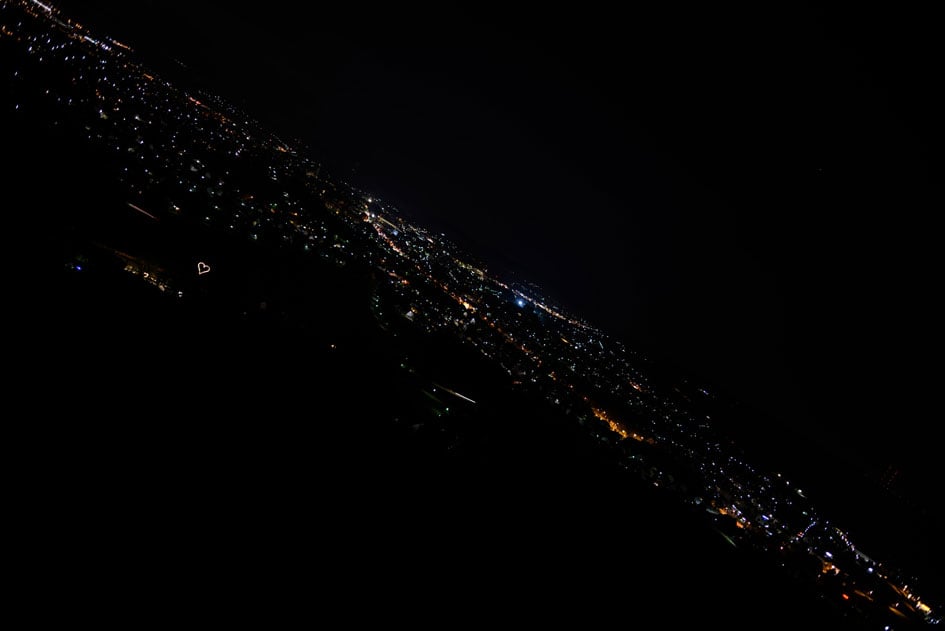
Above: Nikon 24/1.8G at f1.8; also available at f2.0, f2.8, f4.0, f5.6, f8.0

Above: Nikon 24/1.8G; FX-corner at f1.8 (left), f2.8 (middle), f4.0 (right)
Rendering of out-of-focus point-light sources
This test is for the rendering of point-light sources in an out-of-focus background. The circle of confusion that is produced by this test is pretty indicative of Bokeh performance (in the background) and light fall-off. Ideally the out-of-focus image of the point-light is evenly lit and perfectly circular, with no “onion-rings”, and without coloration. Large aperture lenses normally produce an effect known as “cat’s eye” the further away from the optical axis the point-light is projected. This is due to optical vignetting in the lens barrel when light enters the lens from an angle.
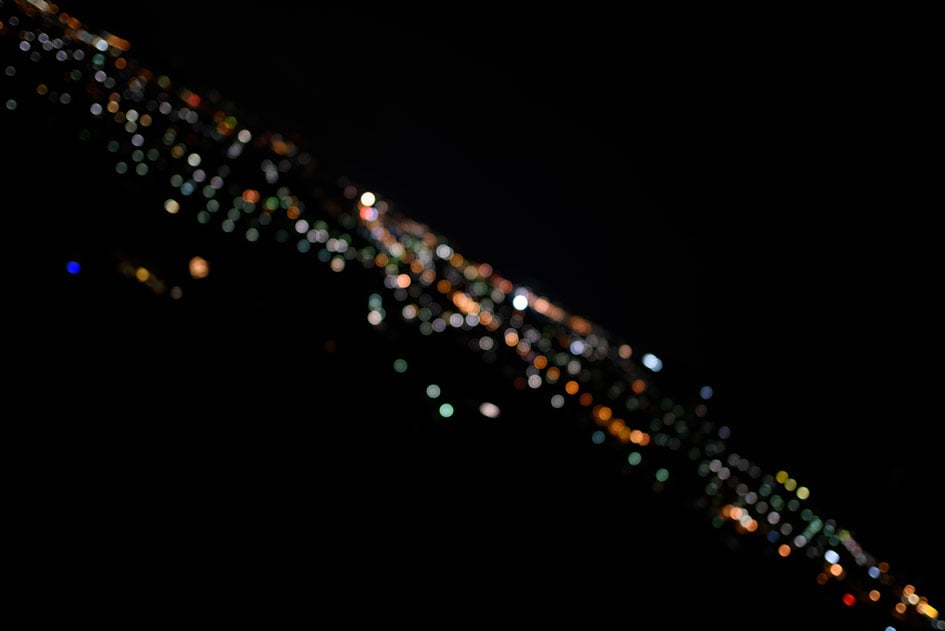
Above: Nikon 24/1.8G at f1.8; also available at f2.0, f2.8, f4.0, f5.6, f8.0

Above: Nikon 24/1.8G at f1.8. 50% crop from center, APS-C/DX-corner, FF/FX-corner.
As the 50% crops above show: The Nikon 24/1.8G produces only a small circle of confusion. It exhibits an uneven light-distribution across the circle with a brighter spot in the middle and a green outline which stems from the longitudinal CA of this lens. Interestingly the lens does not show prominent onion rings although it has two aspherical elements. The cat’s-eye effect towards the borders/corners of the sensor is pretty moderate and there is no clipping from the mirror-box.
Following are 50% crops from a similar shot with the Sigma 24/1.4 Art and the Nikon 24/1.4G at their largest aperture f1.4. All three lenses were focused to the same 1:28 magnification.

Above: Sigma 24/1.4 Art at f1.4. 50% crop from center, APS-C/DX-corner, FF/FX-corner.

Above: Nikon 24/1.4G at f1.4. 50% crop from center, APS-C/DX-corner, FF/FX-corner.
The Nikon 24/1.4G produces the biggest “Bokeh balls” in the center: their diameter is around 30% larger than from the Nikon 24/1.8G. All three lenses show some green outlining but the Nikon 24/1.4G has the least obtrusive light distribution across the disk in the center. Towards the corners the Bokeh balls shrink and are compressed beyond a circular shape. All three lenses also develop some bright outlining in the FX-corner which typically produces nervous Bokeh. But the f1.4 lenses still generate bigger Bokeh blobs in the corners at f1.4 than the Nikon 24/1.8G.
Now let’s see how this analysis of out-of-focus point-light sources translates into Bokeh-performance shooting a book-shelf.
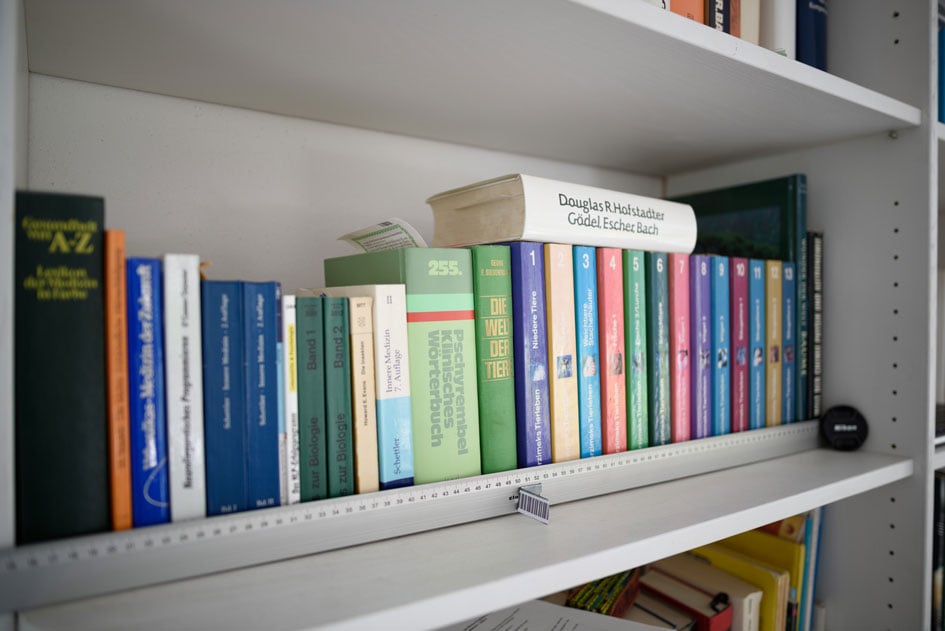
Above: Nikon 24/1.8G at f1.8; also available at f2.8, f4.0, f5.6

Above: Nikon 24/1.8G at f1.8. 50% crop from foreground, middle-ground, background
While the foreground blur is OK, the background shows some outlining and looks nervous. The middle-ground suffers from some longitudinal CA coloring the black letters green. So the Nikon 24/1.8G is certainly not the best 24mm lens with regard to Bokeh.
Flare/ghosting
Catching a strong light-source shining directly into the lens is a real risk with wide-angle lenses – even with the lens-hood attached. That could produce strange colorful ghosts-images or reduce contrast considerably through flare and glare. The appearance of flare and ghosting depends on factors like the aperture and the angle of the light hitting the lens. So to judge the proclivity of the Tamron for these artifacts I went through a series of well calculated shots against a strong light source to provoke glare and ghosting.
The results are very good: Wide open there was so little flare/ghosting that it’s not worth showing an example here. And stopped down to f11 there is also little to report and only when the light is in the frame. In the following shot you can see a colorful flare with a strange multi-dot ghost and a greenish coloration in the upper right corner from another faint ghost:
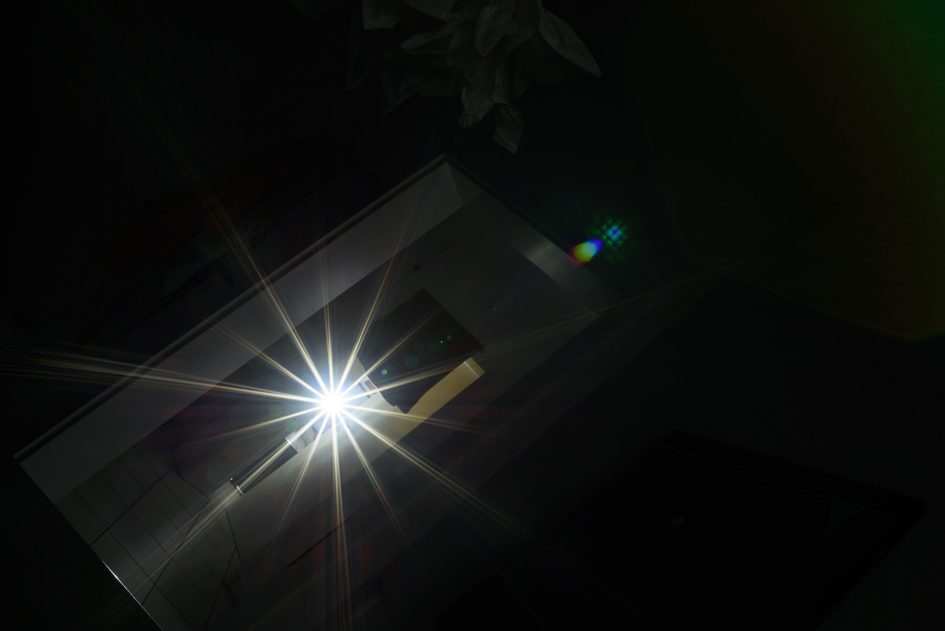
Above: Strong light hitting the Nikon 24/1.8G from inside the image frame at f11
Considering the extreme test-conditions flare and ghosting are very moderate – much less than I’ve seen from other lenses.




